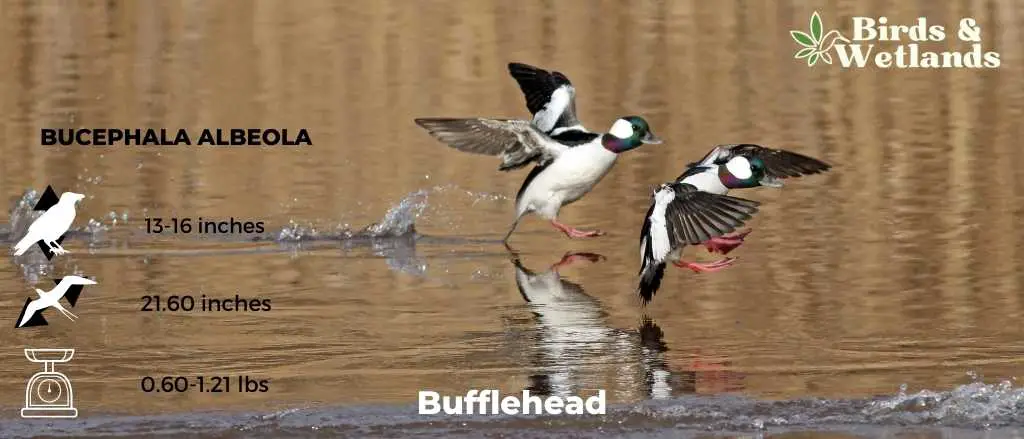The bufflehead (Bucephala albeola) is a small diving duck native to North America. With its namesake puffy head, it stands out among other waterfowl that inhabit the continent’s rivers and lakes.
These diminutive divers are often seen in pairs or small groups, rarely gathering to form larger flocks. Unlike most ducks, they tend to be less sociable and prefer to keep their distance from others.
Buffleheads also have an impressive knack for taking flight quickly and easily, rapidly beating their wings as they soar into the sky.
The origin of their name comes from ‘buffalo-head’ due to their peculiar puffed-up heads, which adds an extra layer of character to these ducks and makes them all the more unique.
Scientific Name: Bucephala albeola
Length: 32–40 cm (13–16 in)
Wingspan: 21.6 in (55 cm)
Weight: 270–550 g (9.5–19.4 oz)
Bufflehead Description
Male
The adult male bufflehead is a small duck with a large black head and short bill. Its plumage is largely black-and-white with a glossy iridescent green visible on its head when the light catches it just right. It has a large white patch on the back of the head and pink legs.
The head boasts a white underside, while the back and wings feature an unmistakable dusky dark color. Its chest and flanks are white and easily visible even from great distances, giving it bright, standout contrast. It has a thick neck, rounded wings, and a slender body that tapers down to its small grayish-brown tail.
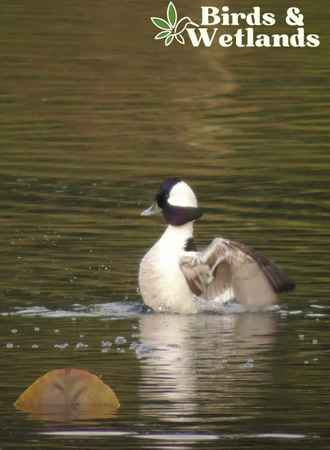
Female
The adult female bufflehead is a small, chubby duck characterized by its round head with a white patch of feathers on its cheek. It has a dark gray bill, a gray-brown plumage dappled with darker spots, and its breast and throat area of the body is covered in white feathers.
The underside and sides of the body are lighter in color, usually light gray or pearl gray – this helps it to blend into its aquatic environment and protect it from predators when swimming.
Juveniles and non-breeding males share the same appearance as the female but with duller plumage.
Listen to Bufflehead
Males emit a squeaky whistle while the females make a hoarse quack.
Bufflehead Habitat & Range
Buffleheads breed in the boreal forest and aspen parkland of northern Canada, Vancouver Island in British Columbia, central Alaska and the Aleutian Islands. However, there are also small flocks in certain parts of the western United States.
This duck species takes advantage of the Northern Flicker’s nesting cavities since they are smaller than other species of ducks, like the common goldeneye. These larger ducks cannot fit into the narrow crevices on poplar trees and aspen trees.
Wintering buffleheads avoid open coastlines during winter and prefer more sheltered coves, harbors, estuaries, or beaches. Buffleheads can be found on ponds, lakes, impoundments, or sheltered bays along slow-moving rivers when not near coastal regions during this season.
These birds spend the winter in central and southern United States. Some flocks have been spotted in southern Florida and along the Pacific Coast and East Coast.
During spring migration, they rest in major rivers and valley lakes before returning to their traditional summer nesting grounds.
These small diving ducks have very specific needs for finding suitable habitats. Their preferred habitat includes regular access to freshwater bodies for sheltering and feeding purposes and a selection of nearby wooded areas with enough trees to find ample nesting cavities.
Furthermore, an environment safe from predators such as bald eagles and black bears and containing plenty of food sources is essential for buffleheads’ successful reproduction each year.

Bufflehead Diet & Food Habits
The bufflehead is a diving bird that feeds primarily in saltwater and freshwater habitats. In shallow water, they mainly consume aquatic insects, while in saltwater, they mostly target crustaceans and mollusks.
While these are the primary items of their diet, buffleheads can also feed on aquatic plants and fish eggs if available locally. They mainly forage prey underwater with quick dives to search for food. When they locate potential prey, they dive deeper and use their beaks to capture it.
Buffleheads have a specialized feeding habit known as ‘bunching-up,’ which consists of gathering a group of birds in the same area to compete for food resources. This behavior occurs mainly during breeding when many birds require energy for reproductive activities.
Additionally, due to their relatively small size compared to other ducks, buffleheads often use debris such as logs and rocks near water surfaces and tree cavities to hide from predators while searching for food.
The bufflehead’s diet varies depending on its habitat. It requires an intensive exploration of its environment since not all food sources are easily accessible.
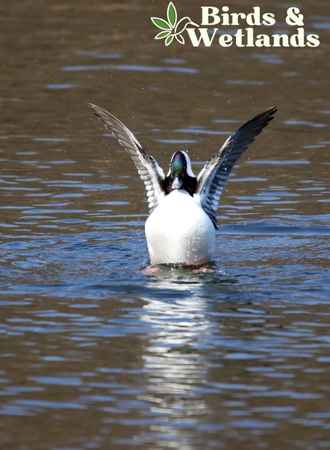
Bufflehead Nesting & Mating Habits
Adult males are known for their elaborate courtship displays such as head bobbing when courting females. One male usually drives the other males while courting a female.
The bufflehead is a monogamous species. The female chooses the nest site. Nests are built in cavities, such as those dug by Northern Flickers or Pileated Woodpeckers, and sometimes in man-made nest boxes.
During the breeding season, females lay between 4 to 17 cream-colored bufflehead eggs, which she incubates for 30 to 35 days. After hatching, the brood of ducklings will remain in the nest for one day before making their first leap from the cavity.
Both parents are responsible for nourishing and protecting bufflehead chicks during this time. The young buffleheads become fully fledged and gain their first flight at around 50-55 days old and will remain with their parents until they make their migratory journey.
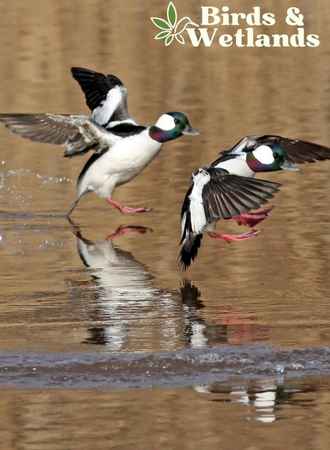
Bufflehead Population & Conservation Status
The bufflehead population has increased steadily since the mid-1960s and is estimated to have a global breeding population of 1.3 million. The species currently has the conservation status of “Least Concern”.
One of the main threats to this species is habitat degradation due to human disturbance and urbanization.
Bufflehead Hunting
Yes, buffleheads can be hunted legally in the United States. They are classified as migratory waterfowl by the U.S. Fish and Wildlife Service, which allows hunting seasons in most places where they are found.
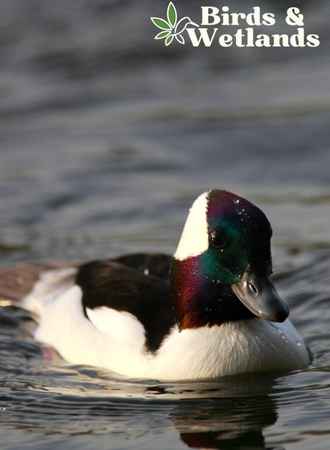
Key Points
- The preferred nesting habitat of the bufflehead is near small lakes and ponds.
- Female buffleheads are cavity-nesting ducks laying between 4 to 17 creamy-white eggs into northern flicker holes.
- This duck’s breeding range is from Alaska to the United States’ northern parts.
- Like most diving ducks, buffleheads dive underwater to search for food.
- Buffleheads eat both plants and small animals.
- These ducks are monogamous, meaning they stay with the same mate until one pair dies.

